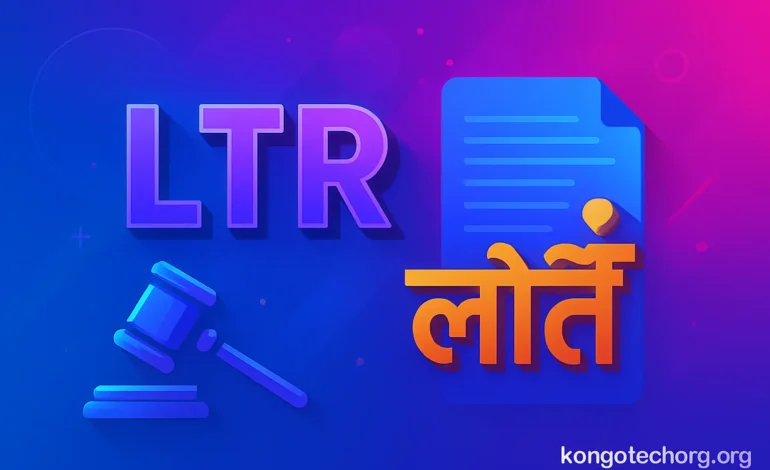LTR Full Form in Law in Hindi – Complete Explanation

Introduction to LTR in Law
When studying legal documents, government records, or land-related cases, you may often encounter abbreviations. One such acronym is LTR. At first glance, it may appear like just another short form, but in the legal field, every abbreviation carries serious weight. Understanding its meaning can prevent confusion and help you better interpret land laws and property-related disputes.
In the context of law, particularly in India, LTR stands for Land Tenancy Record (भूमि किरायेदारी अभिलेख in Hindi). This document is crucial because it reflects the rights, usage, and tenancy agreements related to land. Whether you are a law student, preparing for competitive exams, or dealing with land ownership issues, knowing the LTR full form in law in Hindi is highly important.
What is the Full Form of LTR in Law in Hindi?
In legal terminology, LTR = Land Tenancy Record. In Hindi, it is known as भूमि किरायेदारी अभिलेख.
Simply put, LTR is an official written record that confirms who has legal rights over a piece of land, who is its tenant, and how that land is being used. It functions as both a proof of tenancy and a reference for resolving disputes.
For example:
- If a farmer has leased land for cultivation, his tenancy details will be documented in the LTR.
- If a property owner has rented out land, the LTR reflects that arrangement as well.
Read Also: What Is Viraltips Online and How Do Its Content Strategies Drive Growth?
Why is LTR Important in Legal Matters?
In a country like India, land ownership and tenancy disputes are common. Questions about who owns the land, who uses it, and under what agreement often lead to conflicts. In such situations, the LTR acts as a legal proof.
- It shows whether a piece of land belongs to an owner or is given on lease/tenancy.
- It can be produced in court cases as official evidence.
- It protects both landowners and tenants by providing a transparent record of rights.
This makes LTR not only important for lawyers and courts but also for students, exam aspirants, and citizens handling property-related matters.
LTR in the Indian Legal Context
India’s land laws are complex and vary from state to state. Despite these variations, the importance of tenancy and ownership records remains the same across the country.
The LTR in India is a document that simplifies legal verification of land usage. For example:
- If a farmer rents agricultural land, this tenancy arrangement will be recorded in the LTR.
- If a dispute arises in the future, the LTR can be presented in court or before government authorities to prove the legitimacy of the claim.
Thus, LTR bridges the gap between land ownership laws and practical disputes by acting as a trusted record.
Difference Between LTR and Other Land Documents
People often confuse LTR with other legal records. Some of the commonly compared terms include:
- ROR (Record of Rights): Focuses mainly on ownership rights of the land.
- Sale Deed: A legal document showing the transfer of property from seller to buyer.
- Lease Agreement: An agreement outlining the terms under which land or property is rented.
Unlike these, LTR is specifically focused on tenancy and usage of land, making it a separate and essential category of legal documentation.
Historical Background of LTR in India
The origins of land tenancy records in India date back to the colonial period. During British rule, land revenue collection was a major source of income for the administration. To make taxation easier, officials began creating detailed records of ownership and tenancy.
Over time, this system evolved, and tenancy records such as LTR became an official part of land governance. Today, while many records are digitized, the historical foundation of LTR remains rooted in revenue and tenancy management.
Use of LTR in Court Cases
In many property disputes, the LTR is used as evidence in legal proceedings. For example:
- If someone is accused of illegal possession of land, the LTR can clarify whether that land was legally leased or owned.
- Courts often refer to LTR records while delivering judgments in tenancy disputes.
- Administrative authorities rely on it to resolve conflicts at the local level.
This makes LTR a legally binding document that can influence court decisions.
How to Obtain an LTR Record
In earlier times, getting land records involved visiting government offices and going through lengthy paperwork. However, with Digital India initiatives, most states now offer land record services online.
To obtain an LTR record:
- Visit your state’s official Revenue Department or Land Records Department website.
- Enter details such as account number, survey number, or landholder name.
- Download the LTR certificate/record directly from the portal.
This digitization has made tenancy verification faster, transparent, and less prone to corruption.
LTR and Legal Studies
For law students, preparing for competitive exams, or practicing lawyers, understanding LTR is essential. Many exam questions revolve around abbreviations and their legal implications. Additionally, in property law and land dispute cases, tenancy records like LTR frequently appear.
Thus, LTR knowledge strengthens both academic preparation and professional practice.
Common Misconceptions About LTR
One of the most common misconceptions is that LTR is relevant only in rural areas. This is not true.
- In urban areas, tenancy and property disputes also occur. Commercial plots, housing complexes, and rented properties often rely on tenancy records.
- In rural areas, LTR is crucial for agricultural tenancy and farmer rights.
Hence, LTR plays a significant role in both rural and urban contexts.
Future of LTR in India
The Indian government continues to modernize land governance systems. With the Digital India campaign, the focus is on making all land records transparent and accessible.
In the future:
- LTR documents will likely be fully digital.
- Access will become easier for both citizens and authorities.
- This will reduce corruption, save time, and improve efficiency in legal and property matters.
The future of LTR lies in seamless integration with digital platforms, ensuring that tenancy and land ownership disputes can be resolved more efficiently.
Conclusion
By now, it is clear that LTR Full Form in Law in Hindi = Land Tenancy Record (भूमि किरायेदारी अभिलेख). It is far more than just an abbreviation. LTR is a cornerstone of India’s land governance system, providing clarity in ownership, tenancy, and land usage disputes.
For law students, professionals, exam aspirants, or anyone dealing with land-related issues, understanding LTR is vital. It not only helps in legal interpretation but also ensures fairness in resolving conflicts. In the legal world, every acronym carries depth, and LTR is a prime example of how three letters can represent an entire system of rights and justice.
FAQs about LTR in Law
Q1. What is the full form of LTR in law in Hindi?
LTR stands for Land Tenancy Record (भूमि किरायेदारी अभिलेख), which documents land tenancy and usage.
Q2. Why is LTR important in legal matters?
It serves as legal proof in ownership and tenancy disputes, often used as evidence in courts.
Q3. How can I get my LTR record?
Most states provide LTR records online via official revenue or land record portals.
Q4. Is LTR only for rural land?
No, LTR applies to both rural and urban areas, covering agricultural as well as commercial properties.
Q5. Can LTR be used in court as evidence?
Yes, LTR is a valid legal document accepted in courts to resolve land disputes.
Q6. What is the difference between LTR and ROR?
ROR highlights ownership rights, while LTR focuses specifically on tenancy and land usage.




